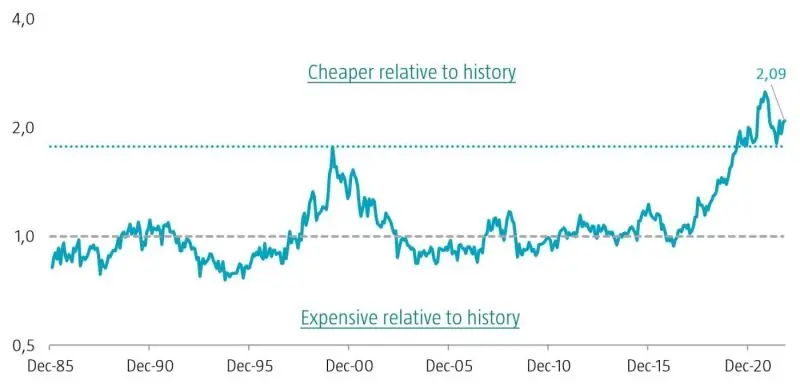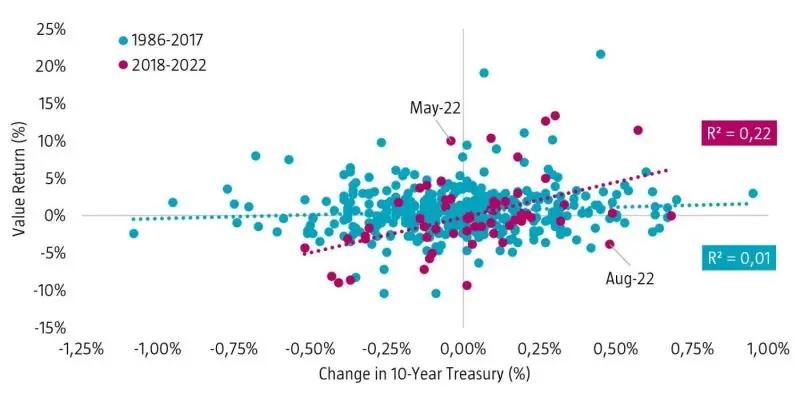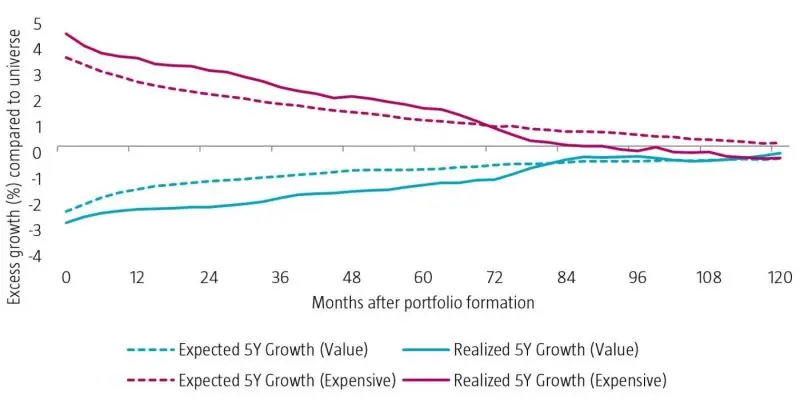The poor performance delivered by value strategies from 2018 to 2020 was accompanied by an extreme widening of valuation multiples between value and growth stocks, with the former getting cheaper than the latter. But the solid recovery over the last two years could perhaps leave some investors wondering whether the value style is now less attractive.
Value factor remains relatively cheap in historical terms
In Figure 1 we show the valuation spread of the value factor,1 meaning the differences in valuation multiples of value and growth stocks.2 As we control for valuation differences that are normally observed between both portfolios, a valuation spread that is above one indicates cheapness, while a reading below one implies that the factor is relatively expensive.
Figure 1 | Composite valuation spread of the enhanced Value factor

Source: Robeco, Refinitiv. The chart shows the composite valuation spread between the top and bottom quintile portfolios of the enhanced value strategy. The investment universe consists of constituents of the MSCI Developed and Emerging Markets indices. Before 2001, we use the FTSE World Developed index for developed markets (going back to December 1985), and for emerging markets, the largest 800 constituents of the S&P Emerging BMI at the semi-annual index rebalance (going back to December 1995). The value spread is the average spread of the book-to-market (R&D adjusted), EBITDA/EV, and CF/P. The sample period is January 1986 to October 2022.
Interestingly, the spread has only shrunk slightly during this period. More specifically, it is still wider as at the end of October 2022 than it was at the beginning of the value winter in 2018. To put things into perspective, the current spread is even wider than it was at the peak of the dot-com bubble in 2000.
Furthermore, value is not only cheap from a relative perspective, but also on an absolute basis as it trades at a forward price-to-earnings ratio (PE) of slightly above 8x. Therefore, the medium-term return expectations for Value are bright, especially if valuations revert to ‘normal’ levels (more on this in the full article).
Despite the strong recent recovery, the value factor is still cheaper than it was at the beginning of its drawdown. This is because, while changes in the value spread explain a large portion of the value returns, they do not explain them entirely. The remaining variation stems from three components: namely carry, portfolio migration and changes in fundamentals (these are discussed in detail in the full article).
Value is not just a beneficiary of rising yields
A popular question is whether the latest rise in interest rates caused the recent value comeback. In our 2021 article,3 we already investigated this notion and documented that while the relationship has been evident recently, it is much weaker over the long run and for longer-return horizons. In this section, we revisit this issue but approach it in a less technical way.
Figure 2 illustrates the relationship between US value returns and contemporaneous changes in the US 10-year Treasury yield. The chart confirms our previous research results as we find little to no evidence that the value factor correlates to interest rate changes for the period spanning from January 1986 to December 2017. However, the correlation has been higher over the last five years.
Figure 2 | Value returns and interest rate changes

Source: Robeco, Refinitiv, FRED. The chart shows the relationship between U.S. value returns and contemporaneous changes in the U.S. 10-Year Treasury yield. The investment universe consists of U.S. constituents of the MSCI Developed Market Index. Before 2001, we use the FTSE World Developed Index (going back to December 1985). The sample period is January 1986 to October 2022.
But even in recent years, the relationship has been far from perfect. In fact, changes in interest rates explain only a small fraction of the variation in the value returns. Interestingly, the last few months indicate that the relationship may have weakened again. For instance, May 2022 was an excellent month for value while yields slightly decreased, whereas August 2022 was a rather bad month for the factor even though interest rates increased by nearly 50 basis points.
Based on this analysis, we believe that the relationship between value returns and interest rates is not structural – or causal – but more a temporary phenomenon that might well provide some tailwinds for value in the months ahead. However, while the positive relationship between value and yields might persist for some time, possibly due to some self-fulfilling prophecy, we do not believe that interest rates will be the decisive factor for value in the years ahead.
Growth stocks do not necessarily have higher future growth
One reason many investors might believe that interest rates drive the returns of the value factor could be based on the argument that growth stocks exhibit longer duration than their value counterparts. Therefore, they should benefit from a lower discount rate being applied to their cashflows and suffer from rising yields.
We acknowledge this line of reasoning but believe that the relationship is ambiguous, meaning one could argue that value stocks are ‘bond-like’ as their prices are driven less by growth expectations and more by their earnings and dividend power in the years ahead. This would imply a negative relationship between value returns and interest rates.
That said, we looked into whether expensive stocks really do have higher future growth. In our analyses, we sort stocks based on valuation multiples and not on past or expected growth. And while companies with high historical growth in sales or earnings typically trade at higher multiples, future long-term growth is much harder to forecast.
Figure 3 depicts the previous five-year realized growth in earnings and analysts’ long-term (five-year) earnings per share (EPS) growth expectations at portfolio formation (t=0), and up to ten years (t=120) after this for the cheap (‘value’) and expensive (‘growth’) quintile portfolios versus the universe. The chart shows that the spread for both historical growth and growth expectations between value and expensive firms is indeed highest at portfolio formation.
Figure 3 | Realized and expected earnings growth for Value quintiles after portfolio formation (AC)

Source: Robeco, Refinitiv, I/B/E/S. The chart shows the previous 5-year realized growth in earnings and the long-term (5-year) EPS growth expectations of analysts for the top (value) and bottom (expensive) quintile portfolios of the enhanced value strategy at portfolio formation (t=0) and up to ten years (t=120) after portfolio formation. For each measure and month, we compute the median for both the cheapest and most expensive quintile and deduct the universe median. The investment universe consists of constituents of the MSCI Developed and Emerging Markets indices. Before 2001, we use the FTSE World Developed index for developed markets (going back to December 1985), and for emerging markets, the largest 800 constituents of the S&P Emerging BMI at the semi-annual index rebalance (going back to December 1995). The sample period is January 1986 to October 2022.
Analysts expect expensive companies to generate about 4% higher EPS growth than the average company, while value firms are expected to deliver around 2.5% lower growth. These numbers are remarkably similar to the realized growth numbers that the two groups of stocks achieved over the five years before portfolio formation. Therefore, it seems that analysts extrapolate past growth into the future.
This difference in growth expectations is a key reason why investors are willing to pay a higher price for growth firms. However, these differences are not persistent. As shown in the chart, the spread in both growth expectations and realized growth rapidly converges in the years after portfolio formation, with value stocks experiencing improvements in growth realizations and expectations, whereas their expensive peers encounter deteriorating growth realizations and expectations.
After eight years, we see that the actual difference is less than 1%. Therefore, investors appear to be overpaying for the expected growth differences at portfolio formation, as analysts and other market participants extrapolate historical growth too far into the future. In other words, realized growth does not live up to expectations. As a result, we view these converging growth expectations as one of the driving forces behind the value premium.
Read the full articleFootnotes
1 We define value as in Blitz, D. C., and Hanauer, M. X., January 2021, “Resurrecting the value premium”, Journal of Portfolio Management. More specifically, the enhanced value strategy is based on a composite of book-to-market (R&D adjusted), EBITDA/EV, CF/P, and NPY metrics. Value stocks are sorted into quintile portfolios based on the valuation composite, in a region and sector neutral manner for developed markets and in a country neutral manner for emerging markets. Quintile portfolios are equal-weighted and rebalanced monthly. Our sample comprises the standard MSCI All Countries Index constituents, i.e., large and mid-cap stocks across both developed and emerging markets.
2 The ‘value spread’ is expressed as the ratio of a basket of valuation multiples of the top and bottom quintile value portfolios. We control for value spread differences that are normally observed between both portfolios, such that a value spread above one indicates cheapness. Since cheap stocks by definition have higher fundamental value to price ratios than their expensive peers, it is particularly important for the value factor to scale the value spread by its historical normal level.
3 Baltussen, G., Hanauer, M. X., Schneider, S., and Swinkels, L., September 2021, “What valuations and interest rates tell us about equity factors”, Robeco article.
時刻把握我們最新市場觀點及電子報
接收荷寶電子報,率先閱讀最新洞察分析,並構建最綠色的投資組合。
免責聲明
本文由荷宝海外投资基金管理(上海)有限公司(“荷宝上海”)编制, 本文内容仅供参考, 并不构成荷宝上海对任何人的购买或出售任何产品的建议、专业意见、要约、招揽或邀请。本文不应被视为对购买或出售任何投资产品的推荐或采用任何投资策略的建议。本文中的任何内容不得被视为有关法律、税务或投资方面的咨询, 也不表示任何投资或策略适合您的个人情况, 或以其他方式构成对您个人的推荐。 本文中所包含的信息和/或分析系根据荷宝上海所认为的可信渠道而获得的信息准备而成。荷宝上海不就其准确性、正确性、实用性或完整性作出任何陈述, 也不对因使用本文中的信息和/或分析而造成的损失承担任何责任。荷宝上海或其他任何关联机构及其董事、高级管理人员、员工均不对任何人因其依据本文所含信息而造成的任何直接或间接的损失或损害或任何其他后果承担责任或义务。 本文包含一些有关于未来业务、目标、管理纪律或其他方面的前瞻性陈述与预测, 这些陈述含有假设、风险和不确定性, 且是建立在截止到本文编写之日已有的信息之上。基于此, 我们不能保证这些前瞻性情况都会发生, 实际情况可能会与本文中的陈述具有一定的差别。我们不能保证本文中的统计信息在任何特定条件下都是准确、适当和完整的, 亦不能保证这些统计信息以及据以得出这些信息的假设能够反映荷宝上海可能遇到的市场条件或未来表现。本文中的信息是基于当前的市场情况, 这很有可能因随后的市场事件或其他原因而发生变化, 本文内容可能因此未反映最新情况,荷宝上海不负责更新本文, 或对本文中不准确或遗漏之信息进行纠正。


